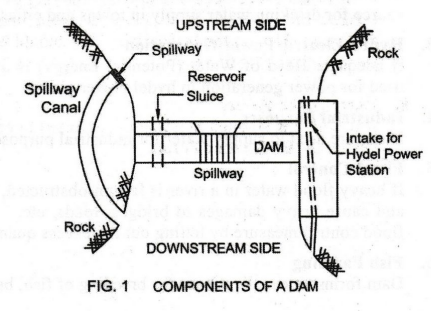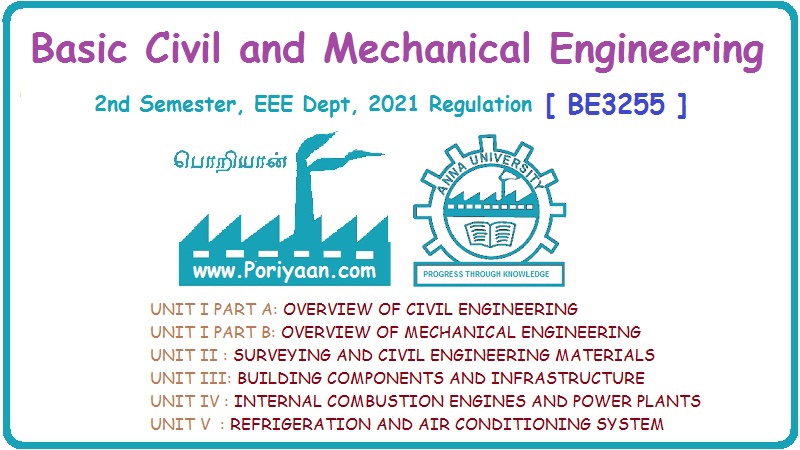Basic Civil & Mechanical Engineering: UNIT III: k. Dams
Dams
Components, Purposes, Selection of Site for Dam | Civil Engineering
Dam: A Dam is a heavy hydraulic structure, constructed across a river. It stores water on one side up to a certain level. Dam is an impervious barrier (obstruction), built across a natural stream of water so that a Reservoir is formed.
UNIT - III
Chapter – 8
DAMS
DAMS
1. COMPONENTS OF A DAM (Fig. 1)
1.
Dam:
A Dam is a heavy hydraulic structure, constructed across a river. It stores
water on one side up to a certain level. Dam is an impervious barrier
(obstruction), built across a natural stream of water so that a Reservoir is
formed.
2.
Reservoir: The total impounded water collected on the upstream
side is called Reservoir.
3.
Upstream Side: Side of the dam on which water gets
collected is called Upstream Side.
4.
Downstream Side: It is the stretch of the stream below
or down the dam.
5.
Catchment Area: Catchment Area is the rainfall area on
the upstream side of the dam. It is feeding water to the reservoir of the dam.
The catchment area decides the capacity of the reservoir as well as the height
of the dam.
6.
Spillway: Spillway is the waterway for the overflow of a dam.
It acts as a safety valve for the dam. Its function is to let out the excess
water from the dam to the downstream side. Otherwise, the excess water in the
dam may cause breach of the dam due to over-storage.
7.
Crest: Crest is the top surface of the dam. It may be used
as road way.
8.
Sluice or Gate: It is the component of a reservoir with
regulating arrangement to control the quantity of water. Through the sluice,
water is let out from the upstream side of the dam.
9.
Heel: Heel of the dam is the upstream end of the base of
the dam.
10.
Toe:
Toe of the dam is the down stream end of the base of the dam.
11.
Full Reservoir Level (F.R.L.):
Full
Reservoir Level is the level up to which water can be stored in the reservoir
of the dam.
12.
Gross Storage Capacity of the Reservoir: It is the total
quantity of water stored in the reservoir up to the full reservoir level.

13.
Live Storage: Live Storage is the quantity of water
stored in the dam from the level of the lowest set of sluices to the full
reservoir level.
14.
Dead Storage: Dead Storage is the quantity of water
stored below the level of the lowest set of sluices in the dam. This water
cannot be released out and used for irrigation, etc.
15.
Mean Sea Level (M.S.L.): Mean Sea Level means the height of
the dam above the sea level.
16.
Maximum Water Level (M.W.L.) or High Flood Level (H.F.L.):
During floods, water may be allowed to rise above the full reservoir level to a
certain maximum level, called Maximum Water Level (M.W.L.) or High Flood Level
(H.F.L.). Top surface of the dam is always constructed above the Maximum Water
Level of the reservoir.
17.
Free Board: Free Board is the difference in height
between the top surface of the dam (crest) and the Maximum Water Level of the
reservoir.
18.
Drainage Gallery: It is a passage left inside the dam,
provided along the length of the dam above the river bed. Its purposes are: (i)
To drain the water seeping through the foundation and upstream masonry and (ii)
To serve as a longitudinal inspection chamber.
19.
Anacut: Anacut is the area to be irrigated by a dam.
20.
Stability of Dam Structure: The load of the heavy structure of
the dam acts vertically downwards on the foundation. Due to the storing of
water in the reservoir in the upstream side, a lateral thrust of high magnitude
acts on the dam. This thrust tends to push the dam to the downstream side.
2. PURPOSES OF A DAM
1.
Irrigation
Stored
water in the dam is mainly used for irrigation purposes. Rain fall is not
evenly distributed throughout the year. Dam is used to store the surplus water
available during rainy season which would otherwise flow into the sea. The
water thus stored is used for irrigation purposes during dry months.
2.
Drinking Water Supply
In
areas of ground water shortage, the stored water in the dam can be used as a
very good source for drinking water supply in towns and cities.
3.
Hydro-Electric Power Generation
If
adequate Head of Water (Potential Energy) is available in the reservoir of the
dam, it is used for power generation in hydel power plants.
4.
Industrial Purposes
Dams
are used to supply water for industrial purposes.
5.
Flood Control
If
heavy flood water in a river is left un-obstructed, it will result in heavy
loss of human lives and cause heavy damages to bridges, roads, etc. The dam
across the river acts as a good flood control measure by letting out the excess
quantity of water.
6.
Fish Farming
Dam
forms an excellent base for breeding of fish, because of continuous
availability of water.
7.
Recreational Purposes
The
dam serves as an excellent place for recreations such as boating, swimming,
etc. Thus, the dam makes it a place of tourism importance.
8.
Storage of Water for Navigation
In
some places, reservoirs are constructed and the backwater of reservoir provides
a very deep channel for navigation.
Multi-purpose
Reservoir: A reservoir planned, designed and constructed to
serve multipurposes such as Irrigation, Drinking Water Supply, Hydro-Electric
Power Generation, Industrial Purposes, Flood Control, Fish Farming,
Recreational Purposes and Navigation.
3. FACTORS GOVERNING SELECTION OF SITE FOR DAM
1.
Catchment Area: Catchment Area should be able to
contribute adequate supply of water to the reservoir of the proposed dam.
2.
Foundation Soil: Sound foundation soil should be
available at the site to carry heavy load. For Earth Dams, any type of
foundation is suitable. However, for Gravity or Concrete or Masonry Dams, sound
rocks at surface or within a reasonable depth, are important.
3.
Ecology: The balance of ecology (means Natural Environment)
should not be disturbed.
4.
River Cross-Section at the Site: River cross-section at
the site should have a narrow gorge (valley) to allow large storage space and
to reduce the length of the dam.
5.
Height of the Dam: The dam cost is proportional to the
square of the dam height. . Therefore, the height should be minimum for the
intended storage of water.
6.
Storage Capacity: The dam should provide adequate storage
capacity for the reservoir.
7.
Costs: The dam should have minimum construction and
maintenance costs.
8.
Reservoir Silting: The site should be such that reservoir
silting is minimum.
9.
Spillway: Suitable location for Spillway should be available
in the near vicinity.
10.
Submergence: Value of the land submerged by the
proposed dam should be as low as possible. It should be less than the benefits
expected from the dam. The rehabilitation of the people displaced due to
submergence is a problem to be tackled in the case of large dams.
11.
Bed Level: The bed level of the dam should preferably be on a
higher level than that of the river basin to facilitate drainage.
12.
Water-Tight: The reservoir should be water-tight.
Otherwise, the stored water may escape through its bed and banks.
13.
Topography: The topography of the site should be
such that the length of the dam should be as small as possible. Also, for a
given height, the storage capacity should be as high as possible. Therefore,
the river valley at the site should be as narrow as possible for maximum
storage capacity.
Basic Civil & Mechanical Engineering: UNIT III: k. Dams : Tag: : Components, Purposes, Selection of Site for Dam | Civil Engineering - Dams
Related Topics
Related Subjects
Basic Civil and Mechanical Engineering
BE3255 2nd Semester 2021 Regulation | 2nd Semester EEE Dept 2021 Regulation
